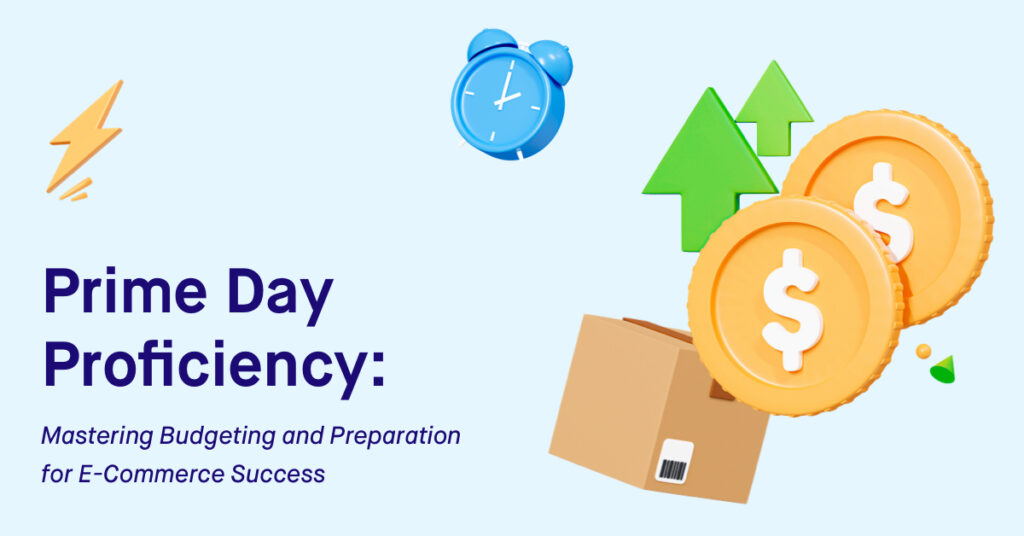Amazon Prime Day has become a historic event for e-commerce sellers worldwide, offering new possibilities for growth and profit. As sellers prepare for Prime Day, mastering budgeting and planning is essential for maximum success. In this blog, we’ll review budgeting basics, key metrics, and actionable strategies to help improve performance and achieve e-commerce success on Prime Day.
Understanding the Significance of Prime Day
Prime Day is more than just a sales event; it’s a strategic opportunity to promote the products, increase sales, and raise brand visibility on one of the world’s largest e-commerce platforms. With billions of dollars in sales and millions of shoppers looking for bargains, Prime Day is an excellent opportunity to capitalize on the increased customer demand.
Effective Budgeting Strategies
Effective budgeting is essential for maximizing returns on Prime Day. Sellers must strategically allocate the resources, weighing ad spend against potential returns. Sellers can optimize their budget for Prime Day’s success by analyzing previous performance data, forecasting sales projections, and establishing specific budgetary objectives.
During Prime Day, several key metrics are critical for evaluating performance and making decisions. Let’s look at how these metrics affect budgeting and planning.
CPC (Cost Per Click): Prime Day usually brings more competition, which means higher CPCs. Cost-effective advertising requires close monitoring of CPC trends and adjusting bidding strategies as needed.
ACOS (Advertising Cost of Sales): An essential metric for determining the effectiveness of advertising campaigns, ACOS can fluctuate during Prime Day due to changes in ad spend and sales performance. Maintaining a competitive ACOS while increasing sales and profits is essential for business success.
Ad Spend: Prime Day often necessitates a higher ad spend to stand out in a crowded marketplace. Setting realistic ad budgets based on sales targets ensures enough investment to boost visibility and conversions.
Ad Sales: Tracking ad sales is essential for determining the impact of advertising campaigns on revenue. Analyzing ad sales data in real time and adjusting campaign strategies as needed allows businesses to capitalize on opportunities while mitigating risks.
RoAS (Return on Advertising Spend): RoAS measures the effectiveness of advertising investments by comparing ad revenue to ad spend. Businesses should strive for a positive ROAS, which shows that their advertising efforts are profitable.
Success Strategies Unveiled: Your Roadmap to Victory
Are you geared up to conquer Prime Day? Success requires meticulous planning, strategic advertising, and staying ahead of inventory demands. Set specific sales targets and allocate budgets wisely. Create compelling content and use high-performing keywords to captivate your audience.
After Prime Day, sellers should conduct a thorough performance analysis to fine-tune future strategies. Mastering budgeting skills and staying on top of critical metrics are essential in the e-commerce industry.
Sellers can capitalize on Prime Day’s unprecedented growth opportunities with careful planning and strategic execution. Take advantage of this opportunity to take your business to new heights. Begin planning for your most successful Prime Day yet!
Tips from the Trenches: Insights from Prime Day 2023
- Sellers can effectively market their brand by using captivating video content.
- They should use the Prime Day frenzy to catch shoppers’ attention by incorporating their images.
- It is essential to anticipate the competition and stay ahead by using insights from past campaigns to perfect their marketing strategy.
- To attract attention, sellers should prominently display their best-selling products.
- Strategically managing distribution costs is crucial for maximum output.
- By utilizing multi-ad products and ad types, sellers can expand their reach more effectively.
2024 Prime day: What to expect?
According to current data and predicted trends, it is expected that Amazon Prime Day 2024 will experience significant growth following the success of last year’s event. The previous year’s event saw 375 million items sold worldwide, making it the most prominent Prime Day event for independent sellers. Amazon reports that some smaller businesses saw an increase in their average daily sales of over 18 times. The year-over-year increase in Amazon traffic suggests an increase in shoppers for Prime Day and future events. Due to increased competition for CPC, sellers are likely to increase their advertising budgets to reach Prime Day shoppers. The anticipated increase in shoppers during Prime Day will result in higher sales volumes, potentially doubling sales compared to previous Prime Day events. As a result, Prime Day has become an essential sales event for sellers to showcase their products and engage with a large audience.





